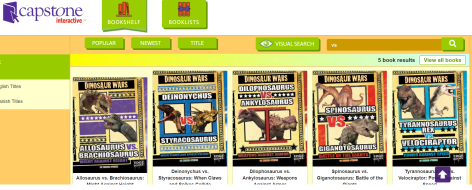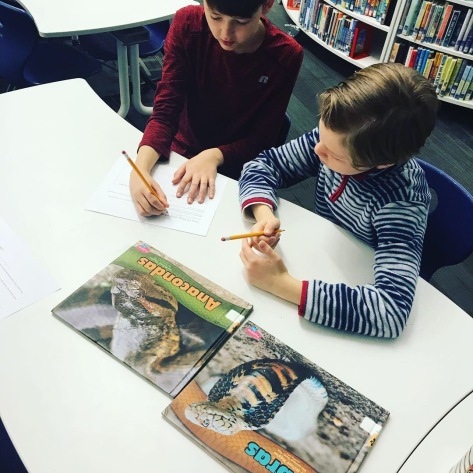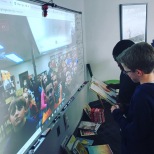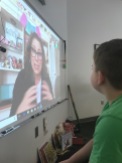
Our 2nd graders gathered in the library for the 6th annual announcement of the Barrow Peace Prize. During this special ceremony, we connect with the team at Flipgrid. Each year, the Flipgrid team grows, and this year we connected with them at their headquarters in Minnesota and also in other locations where team members were working. The kids loved seeing their many faces on the screen celebrating their work.
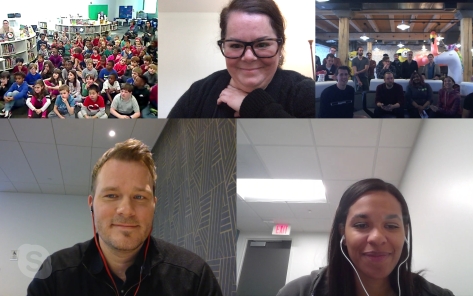
Before our Skype, I showed students a map of places their voices were heard around the world. They were amazed by the pins in over 110 different locations and counting.

During our ceremony, we started with some introductions and greetings from the Flipgrid team. Then, we took time to hear some special stories from the project. Every year, we get comments on social media about the project which I share with the students. They love having a personal connection with people who have heard their voices.

This year, I had a message exchange with an individual from Canada. She messaged me through our library Facebook page, so I shared her message with the students.
Marion Hodges from Canada says: “greetings from Canada. For the kids who chose Jackie Robinson they might be interested to know that he started his pro career in Montreal with the Montreal Royals. He endured a lot of the same treatment but also a lot of respect. After that he went on to play with the Dodgers. For the kids who chose Rosa Parks – there is a lady named Viola Desmond who did something very similar in Nova Scotia in the 1940s as she refused to leave the “white-only” section of the cinema. She was a successful beautician and entrepreneur and you can see her picture on the Canadian 10 dollar bill.”
Next, we launched into awards. Each teacher selected 3 students to receive one of three awards:
- Prolific Persuader: For using your persuasive techniques to encourage an authentic audience to vote for your civil rights leader.
- Outstanding Openers: For using a creative hook to capture your audience’s attention from the very beginning of your persuasive writing.
- Dynamic Designers: For creating an inspiring piece of art to accompany your persuasive writing and visually engage your audience.
Christine, Marty, and Sindy from Flipgrid announced these student winners. This is one of my favorite parts of the ceremony because the kids erupt in applause for their classmates as they walk up to receive the award. The Flipgrid team applauded each group of students and we took a quick picture with the screen.
Another tradition we have thanks to a former Barrow student is having students design the Barrow Peace Prize. This year, students applied to design the peace prize by submitting sketches or ideas for what it might look like. Six students were chosen. We met together in the library and found ways to combine our ideas into one prize. The design was created in Tinkercad and printed on our Makerbot 3D printer. Each of the designers received a medal. Every student who researched the winner of the 2019 Barrow Peace Prize also received a medal. Finally, each classroom received a medal for students to take turns wearing. Even though we have one winner of the prize, this is a project that we are all contributors to.

Finally came the moment kids have been waiting to hear. The Flipgrid team announced the winner of the 2019 Barrow Peace Prize.
Jackie Robinson received the 2019 Barrow Peace Prize. Kids once again erupted with cheers and applause.

All of the researchers of Jackie Robinson came up to received their medals and take a picture. As soon as students left, I updated our Smore page.
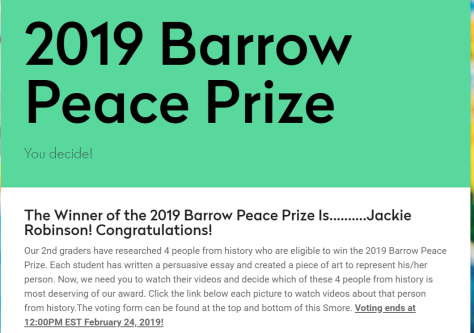
Once again, I was reminded of how special this project is. There are so many ways for students to get engaged with the content whether their strength is art, writing, reading, speaking, designing, or something in between. I love that it gets our student voices out into the world in a positive way and shows our students how far their voices can travel.
Thank you to all of our students and teachers for their hard work on this project. Thank you to all who voted. Thank you Capstone for getting us kicked off each year in our research with PebbleGo. Thank you Flipgrid for amplifying our student voice with your product and celebrating our work each year. We look forward to next year.












 Killer Whale vs. Great White Shark. T-Rex vs. Velociraptor. Scorpion vs. Centipede. These topics grab the attention of so many readers in our library.
Killer Whale vs. Great White Shark. T-Rex vs. Velociraptor. Scorpion vs. Centipede. These topics grab the attention of so many readers in our library.